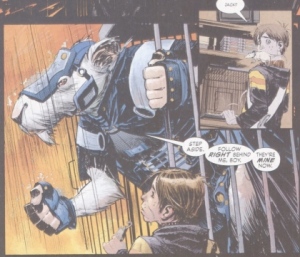Joe the Barbarian (Comic Review)
 Joe is a sullen teenager who would rather retreat into his own imaginary world than face reality. When he falls into a diabetic shock, he gets his wish: A fantasy land populated by his old toys hails him as a savior, and he embarks on a crazy journey only occasionally marred by the reality of him stumbling around a real-world house in search of life-saving sugar.
Joe is a sullen teenager who would rather retreat into his own imaginary world than face reality. When he falls into a diabetic shock, he gets his wish: A fantasy land populated by his old toys hails him as a savior, and he embarks on a crazy journey only occasionally marred by the reality of him stumbling around a real-world house in search of life-saving sugar.
The idea of someone switching between reality and fantasy is certainly not new, but Joe the Barbarian handles it with aplomb. Author Grant Morrison is a master of crazy ideas, and elevates the fantasy setting beyond normal expectations. (Seriously, dwarf pirates whose submarines navigate a pipe system based on Joe’s plumbing? Skull-wearing inventor-monks, whose glimpses of real-world science are confused with magic? The world is just creative enough to imply that there is a solid history beyond the clichéd “toys living in a magic land”.) Artist Sean Murphy provides an understated realism that easily transitions between the dark, grimy real world and a fantasy world that is manic, cartoony, but still threatened by a growing shadow. Even the publisher plays a key role here: As Vertigo is an imprint of DC, Morrison and Murphy are free to pepper their “toyland” with recognizable action figures instead of generic, copyright-skirting approximations.
The transitions between the two worlds, often panel-to-panel, are masterfully done, and it’s impressive that the comic pulls this off without disrupting the pacing. This keeps the stakes high, constantly reminding the reader of the life-and-death battle that’s taking place in two levels at once. Echoing his real-world status, the characters he meets recognize him as a foretold savior named “The Dying Boy”. The conflict is clear: Joe is only able to save them as long as he is in danger of dying from a diabetic hallucination. Will he condemn them all if he gets to a life-saving drink of soda?
 Despite this, the tension would be a lot stronger if the series was more convincing in its hints that these fantasy people might be real. Since everything we see is through Joe’s fevered eyes, any evidence of these creatures’ reality is easy to dismiss as part of his hallucination. The other land is fun and original, but the only conflict that kept me hanging on from month to month was just whether he would get some sugar in his system.
Despite this, the tension would be a lot stronger if the series was more convincing in its hints that these fantasy people might be real. Since everything we see is through Joe’s fevered eyes, any evidence of these creatures’ reality is easy to dismiss as part of his hallucination. The other land is fun and original, but the only conflict that kept me hanging on from month to month was just whether he would get some sugar in his system.
The ending is also surprisingly pat. Morrison unexpectedly makes his only recent creator-owned series more straightforward than the superhero work he has been doing. Warrior-rat Jack must face up to his feelings of inadequacy, the normal-sized pirate prince needs to gain acceptance among his dwarven subjects, and, in a subplot that feels entirely shoehorned in, Joe is in danger of losing his house to foreclosure.
That’s not to say that Joe the Barbarian is bad. Morrison and Murphy are both able to deliver solid results in genre exercises like this, and there are plenty of ideas and developed themes that prove that they aren’t just phoning this in. However, it rarely tries to be more than a straightforward fantasy story about a teenage boy facing his issues. There’s nothing wrong with that, but it isn’t going to appeal to anyone who wouldn’t normally want to read those stories.
Grade: B-












 Chris Samnee provides excellent art. I had not known of him beforehand, but between this title and the recently released Serenity: The Shepherd’s Tale, I’ll be keeping my eye on him. His work is soft and understated, with simple lines calling out emotions, and incredibly natural body language. Every character looks distinct and natural. While that may sound out of place in an action-heavy genre, where artists usually focus on adventure at the expense of portraying the people, Samnee makes it work: When every pose conveys Thor’s quiet, confident strength, the powerful action flows naturally.
Chris Samnee provides excellent art. I had not known of him beforehand, but between this title and the recently released Serenity: The Shepherd’s Tale, I’ll be keeping my eye on him. His work is soft and understated, with simple lines calling out emotions, and incredibly natural body language. Every character looks distinct and natural. While that may sound out of place in an action-heavy genre, where artists usually focus on adventure at the expense of portraying the people, Samnee makes it work: When every pose conveys Thor’s quiet, confident strength, the powerful action flows naturally.